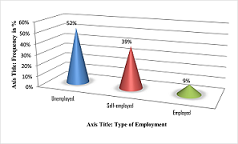References:
[1] C. Avgerou,
“Information systems in developing countries: A critical research review,” Journal
of Information Technology, vol. 23, no. 3. pp. 133–146, Sep. 2008. doi: 10.1057/palgrave.jit.2000136.
[2] R. Kalumendo,
“The Benefits of Technological Developments on Businesses: A Survey Conducted among
SMEs in Beni, Democratic Republic of Congo,” Texila International Journal of
Academic Research, 2022, doi: 10.21522/TIJAR.2014.SE.22.01.Art012.
[3] R. Kalumendo,
“Predictive Factors of IT Systems Adoption by SME Employees in Developing Countries:
Evidence from SME Employees in North Kivu, DRC,” Texila International Journal
of Academic Research, 2022, doi: 10.21522/TIJAR.2014.09.04.Art003.
[4] R. Kalumendo,
“Barriers to SME Computerization in Developing Countries: Evidence from SMEs in
North Kivu, Democratic Republic of Congo,” Texila International Journal of Management,
vol. 8, no. 2, pp. 163–169, Aug. 2022, doi: 10.21522/tijmg.2015.08.02.art013.
[5] M. A. Kurniawati,
“Analysis of the impact of information communication technology on economic growth:
empirical evidence from Asian countries,” Journal of Asian Business and Economic
Studies, vol. 29, no. 1, pp. 2–18, Feb. 2022, doi: 10.1108/jabes-07-2020-0082.
[6] H. K. Çalışkan,
“Technological Change and Economic Growth,” Procedia Soc Behav Sci, vol. 195, pp.
649–654, Jul. 2015, doi: 10.1016/j.sbspro.2015.06.174.
[7] R. P. Estébanez,
E. U. Grande, and M. C. Espada, “Adoption of Information Technology by Micro-enterprises.
Evidence from the Democratic Republic of Congo (DRC),” European Journal of Sustainable
Development, vol. 11, no. 3, p. 167, Oct. 2022, doi: 10.14207/ejsd.2022.v11n3p167.
[8] Matiyabu,
and P. Ndayizigamiye, “Enhancing agricultural practices Through mobile technology
Interventions: a case of the democratic Republic of Congo “, 2019 IEEE Global
Humanitarian Technology Conference (GHTC).
[9] R. J. Torraco,
“Writing Integrative Literature Reviews: Using the Past and Present to Explore the
Future,” Human Resource Development Review, vol. 15, no. 4. Sage Publications
Ltd, pp. 404–428, Dec. 01, 2016. doi: 10.1177/1534484316671606.
[10]
W. Lubbe, W. ten Ham-Baloyi, and K. Smit,
“The integrative literature review as a research method: A demonstration review
of research on neurodevelopmental supportive care in preterm infants,” Journal
of Neonatal Nursing, vol. 26, no. 6, pp. 308–315, Dec. 2020, doi: 10.1016/J.JNN.2020.04.006.
[11]
G. Misganu, Z. Ayenew, and K. Lemi, “An Integrative
Literature Review: Tracing Employee Moonlighting as a Thriving Phenomenon,” Online,
2022. [Online]. Available: http://journals.ju.edu.et.
[12]
R. Whittemore APRN, K. N. Knafl Elizabeth Gray
Distinguished Professor, and K. Knafl, “Methodological Issues in Nursing
Research The integrative review: updated methodology.”
[13]
G. Rigopoulos, J. Psarras, and D. T. Askounis,
“A TAM model to evaluate user’s attitude towards adoption of decision support systems,”
Journal of Applied Sciences, vol. 8, no. 5, pp. 899–902, 2008, doi: 10.3923/jas.2008.899.902.
[14]
N. Marangunić and A. Granić, “Technology acceptance
model: a literature review from 1986 to 2013,” Univers Access Inf Soc, vol.
14, no. 1, pp. 81–95, Mar. 2015, doi: 10.1007/s10209-014-0348-1.
[15]
S.-C. Chen, S.-H. Li, and C.-Y. Li, “Recent
Related Research in Technology Acceptance Model: A Literature Review,” 2011.
[16]
M. J. Mortenson and R. Vidgen, “A computational
literature review of the technology acceptance model,” Int J Inf Manage,
vol. 36, no. 6, pp. 1248–1259, Dec. 2016, doi: 10.1016/j.ijinfomgt.2016.07.007.
[17]
F. D. Davis, R. P. Bagozzi, and P. R. Warshaw,
“User Acceptance of Computer Technology: A Comparison of Two Theoretical Models,”
Manage Sci, vol. 35, no. 8, pp. 982–1003, Aug. 1989, doi: 10.1287/mnsc.35.8.982.
[18]
F. Lin, S. S. Fofanah, and D. Liang, “Assessing
citizen adoption of e-Government initiatives in Gambia: A validation of the technology
acceptance model in information systems success,” Gov Inf Q, vol. 28, no.
2, pp. 271–279, Apr. 2011, doi: 10.1016/J.GIQ.2010.09.004.
[19]
K. F. Yuen, L. Cai, G. Qi, and X. Wang, “Factors
influencing autonomous vehicle adoption: an application of the technology acceptance
model and innovation diffusion theory,” Technol Anal Strateg Manag, Vol.
33, no. 5, pp. 505–519, 2021, doi: 10.1080/09537325.2020.1826423.
[20]
S. G. Fussell and D. Truong, “Using virtual
reality for dynamic learning: an extended technology acceptance model,” Virtual
Real, vol. 26, no. 1, pp. 249–267, Mar. 2022, doi: 10.1007/s10055-021-00554-x.
[21]
E. Park and K. J. Kim, “An Integrated Adoption
Model of Mobile Cloud Services: Exploration of Key Determinants and Extension of
Technology Acceptance Model,” Telematics and Informatics, vol. 31, no. 3,
pp. 376–385, Aug. 2014, doi: 10.1016/J.TELE.2013.11.008.
[22]
V. Venkatesh and F. D. Davis, “Theoretical
extension of the Technology Acceptance Model: Four longitudinal field studies,”
Manage Sci, vol. 46, no. 2, pp. 186–204, 2000, doi: 10.1287/mnsc.46.2.186.11926.
[23]
M. L. Meuter, A. L. Ostrom, M. J. Bitner, and
R. Roundtree, “The influence of technology anxiety on consumer use and experiences
with self-service technologies,” J Bus Res, vol. 56, no. 11, pp. 899–906,
Nov. 2003, doi: 10.1016/S0148-2963(01)00276-4.
[24]
R. P. Juniarti and A. Omar, “Technology Adoption
in Small and Medium Enterprises (SMEs) Current Issues and Future Research Avenues,”
2021.
[25]
M. Ghobakhloo and S. H. Tang, “Information
system success among manufacturing SMEs: case of developing countries,” Inf Technol
Dev, vol. 21, no. 4, pp. 573–600, Oct. 2015, doi: 10.1080/02681102.2014.996201.
[26]
M. Ghobakhloo and S. H. Tang, “Barriers to
electronic commerce adoption among small businesses in Iran,” in E-Commerce for
Organizational Development and Competitive Advantage, IGI Global, 2013, pp.
252–296. doi: 10.4018/978-1-4666-3622-4.ch013.
[27]
The International Trade Centre, “SME Competitiveness
in Francophone Africa 2022. Fostering digital transformation,” 2022.
A.
M. Selase, A. E. Selase, A.-R. Ayishetu, A.
Stanley, and G.-A. Ebenezer, “Impact of Technology Adoption and Its Utilization
on SMEs in Ghana,” International Journal of Small and Medium Enterprises,
vol. 2, no. 2, 2019, [Online]. Available: www.cribfb.com/journal/index.php/ijsmes.
[28]
M. Kyobe, “Investigating the key factors influencing
ICT adoption in South Africa,” Journal of Systems and Information Technology,
vol. 13, no. 3, pp. 255–267, Aug. 2011, doi: 10.1108/13287261111164844.
[29]
K. Bagchi and G. Udo, “Empirically Testing
Factors That Drive ICT Adoption in Africa And OECD set of Nations,” Issues in
Information Systems, vol. 5, no. 2, 2007.
[30]
W. Olatokun, “e-Commerce Technology Adoption
by SMEs in Botswana.” [Online]. Available: https://www.researchgate.net/publication/265223392.
[31]
Brown, Z. Cajee, D. Davies, and S. Stroebel,
“Cell phone banking: Predictors of adoption in South Africa - An exploratory study,”
Int J Inf Manage, vol. 23, no. 5, pp. 381–394, 2003, doi: 10.1016/S0268-4012(03)00065-3.
[32]
S. Bvuma and C. Marnewick, “An information
and communication technology adoption framework for small, medium and micro-enterprises
operating in townships South Africa,” The Southern African Journal of Entrepreneurship
and Small Business Management, vol. 12, no. 1, 2020.
[33]
M. Danquah and J. Amankwah-Amoah, “Assessing
the relationships between human capital, innovation and technology adoption: Evidence
from sub-Saharan Africa,” Technol Forecast Soc Change, vol. 122, pp. 24–33,
Sep. 2017, doi: 10.1016/J.TECHFORE.2017.04.021.
[34]
N. T. Matsepe and E. van der Lingen, “Determinants
of emerging technologies adoption in the South African financial sector,” South
African Journal of Business Management, 2022, doi: 10.4102/sajbm.
[35]
R. Ismail, R. Jeffery, and J.-P. Belle, “Using
ICT as a Value Adding Tool in South African SMEs,” Journal of African Research
in Business & Technology, pp. 1–12, Jan. 2011, doi: 10.5171/2011.470652.
[36]
T. Chitura, S. Mupemhi, T. Dube, and J. Bolongkikit,
“Barriers to Electronic Commerce Adoption in Small and Medium Enterprises: A Critical
Literature Review,” Journal of Internet Banking and Commerce, vol. 13, no.
2, Aug. 2008.
[37]
R. MacGregor, L. Vrazalic, S. Carlsson, D.
Bunker, and M. Magnusson, “The Impact of Business Size and Business Type on Small
Business Investment in Electronic Commerce: a study of Swedish small businesses,”
Australasian Journal of Information Systems, vol. 9, no. 2, May 2002, doi:
10.3127/ajis.v9i2.189.
[38]
M. C. Cant and J. A. Wiid, “Internet-Based
ICT Usage By South African SMEs: The Barriers Faced By SMEs.”
[39]
N. Dlodlo and M. Dhurup, “Barriers To E-Marketing
Adoption among Small and Medium Enterprises (SMEs) in the Vaal Triangle,” Acta Commercii,
2010.
[40]
P. J. Makiwa and R. Steyn, “ICT adoption and
use in Zimbabwean SMEs,” in 2016 IST-Africa Conference, IST-Africa 2016, Aug. 2016.
doi: 10.1109/ISTAFRICA.2016.7530576.
[41]
Apulu, A. Latham, and R. Moreton, “Factors
affecting the effective utilisation and adoption of sophisticated ICT solutions:
Case studies of SMEs in Lagos, Nigeria,” Journal of Systems and Information Technology,
vol. 13, no. 2, pp. 125–143, May 2011, doi: 10.1108/132872611111359.

 An Integrative Literature Review on Technology Adoption by African SMEsAuthor: Rodrigue KalumendoDOI: 10.21522/TIJAR.2014.SE.23.01.Art001
An Integrative Literature Review on Technology Adoption by African SMEsAuthor: Rodrigue KalumendoDOI: 10.21522/TIJAR.2014.SE.23.01.Art001 Effects of Enhance Adherence Counselling on Viral Load Suppression Among High Viral Load HIV Seropositive Patients in a Nigerian Tertiary Health FacilityAuthor: Salami Aisha OluwakemiDOI: 10.21522/TIJAR.2014.SE.23.01.Art002
Effects of Enhance Adherence Counselling on Viral Load Suppression Among High Viral Load HIV Seropositive Patients in a Nigerian Tertiary Health FacilityAuthor: Salami Aisha OluwakemiDOI: 10.21522/TIJAR.2014.SE.23.01.Art002 The Role of Motivation in Enhancing Staff Productivity - A Case Study of Onyix and Company Nigeria LimitedAuthor: Gladys Harold JuwahDOI: 10.21522/TIJAR.2014.SE.23.01.Art003
The Role of Motivation in Enhancing Staff Productivity - A Case Study of Onyix and Company Nigeria LimitedAuthor: Gladys Harold JuwahDOI: 10.21522/TIJAR.2014.SE.23.01.Art003 Sustainability of Donor Funded HIV Prevention, Care, and Treatment Programs for Key Populations in NigeriaAuthor: Margaret ShellengDOI: 10.21522/TIJAR.2014.SE.23.01.Art004
Sustainability of Donor Funded HIV Prevention, Care, and Treatment Programs for Key Populations in NigeriaAuthor: Margaret ShellengDOI: 10.21522/TIJAR.2014.SE.23.01.Art004 Determinants of Antituberculosis Drug Acceptability among Children with Tuberculosis in Osun State NigeriaAuthor: Obioma Chijioke-AkaniroDOI: 10.21522/TIJAR.2014.SE.23.01.Art005
Determinants of Antituberculosis Drug Acceptability among Children with Tuberculosis in Osun State NigeriaAuthor: Obioma Chijioke-AkaniroDOI: 10.21522/TIJAR.2014.SE.23.01.Art005 To Explore the Perceived Food Taboos during Pregnancy and their Relation to Maternal Nutrition and HealthAuthor: Rabecca KayumbaDOI: 10.21522/TIJAR.2014.SE.23.01.Art006
To Explore the Perceived Food Taboos during Pregnancy and their Relation to Maternal Nutrition and HealthAuthor: Rabecca KayumbaDOI: 10.21522/TIJAR.2014.SE.23.01.Art006 Bacteriology of Urinary Tract Infection in Children Attending Federal Staff Hospital in AbujaAuthor: Bassey M GraceDOI: 10.21522/TIJAR.2014.SE.23.01.Art007
Bacteriology of Urinary Tract Infection in Children Attending Federal Staff Hospital in AbujaAuthor: Bassey M GraceDOI: 10.21522/TIJAR.2014.SE.23.01.Art007 The Effect of Total Quality Management on Customer Satisfaction in the Downstream Petroleum Sector in GhanaAuthor: Michael Tetteh OhipeniDOI: 10.21522/TIJAR.2014.SE.23.01.Art008
The Effect of Total Quality Management on Customer Satisfaction in the Downstream Petroleum Sector in GhanaAuthor: Michael Tetteh OhipeniDOI: 10.21522/TIJAR.2014.SE.23.01.Art008
